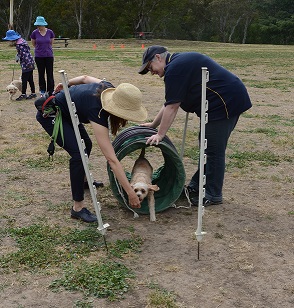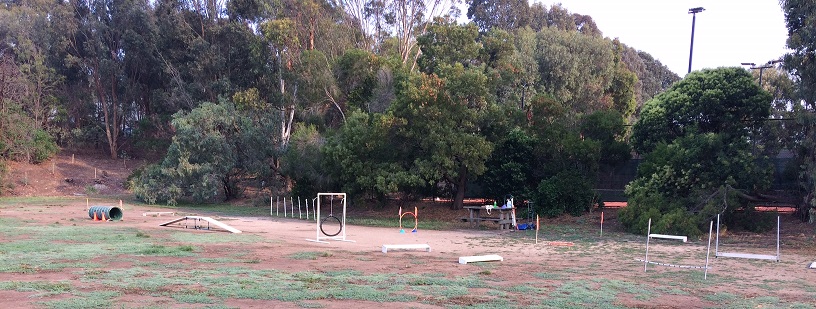Backyard Agility
Agility-style activities are great ways to engage your dog’s mind and body, give alternatives to standard obedience exercises (and additional opportunities for your dog to practice being responsive to you), and deepen the bond between you and your dog. The Gentle Modern School of Dog Training runs Agility Workshops and these are a great start to becoming familiar with agility exercises.
You might like to set-up your own backyard agility course too.
Backyard Agility Guidelines
- Remember to warm-up and cool-down your dog before and after agility
- Consider the surface you are doing the agility activities on; you would do better to avoid activities that involve jumping on surfaces that are hard and/or slippery to minimise the chance of your dog being hurt when landing.
- Break a task into steps and be generous with food rewards.
- To get your dog through, under, or over an obstacle, use a food reward as a lure until he has the idea and only very slowly increase the difficulty (that is how far, how low, how high your dog has to go).
- When you are introducing new agility objects (different types of jumps, for example), let your dog independently investigate them (walk around, sniff, touch) thoroughly first to get used to them.
- Keep an eye on how your dog is responding to an activity. Does he show signs of discomfort or anxiousness? Make it easier for him, reward him more often or change to another exercise.
Important things to remember
- Ensure any ‘equipment’ (e.g. boxes, stool, low table) is sturdy, large enough to comfortably accommodate your dog, stable and on a flat surface
- Jumps must be very low until your dog has reached full physical maturity to protect his joints.
- Start with jump obstacles that are light in weight so they won’t hurt the dog if the dog hits it
- As a rough guide, adult dogs without physical problems can usually jump to the height of their shoulder.
- Dogs with hip or elbow dysplasia should not be encouraged to jump.
DIY Agility Activities
There are lots of options. Here are the most easily set-up:
- A chair with a towel over becomes a tunnel for your dog to go “through” (you can add on more chairs to make the tunnel longer as your dog becomes more proficient).
- A hula-hoop becomes an object to jump through
- Wheelie bins or flower pots become obstacles to heel round
Resources
There are lots of books, websites, YouTube videos, etc. available. Here are a few suggestions:
BOOKS
Ebook: From The Ground Up - Agility Foundation Training for Puppies and Beginner Dogs Kim Collins (Publisher: Dogwise Ebooks)
Agility Bible: A practical guide for handlers Bonny Quick (Publisher: First Stone Publishing)
ONLINE ARTICLES
https://thebark.com/content/agility-training-exercises-your-dog-can-do-indoors
http://www.mnn.com/family/pets/stories/how-to-create-a-dog-agility-course-at-home(references USA products but gives good tips on what to look for in equipment)
http://www.wikihow.com/Build-a-Dog-Agility-Course
YOUTUBE
TheDogBlog Channel has a variety of videos on DIY agility equipment:
Tyre Jump - https://www.youtube.com/watch?v=06wNaILOmxg
Jumps/Weavers - https://www.youtube.com/watch?v=kM9UoqSdIxE
Dog Walk - https://www.youtube.com/watch?v=wChONLQI4VM
See-Saw - https://www.youtube.com/watch?v=K0WZ3bH_naA
CLUBS
Agility Dog Club of Victoria https://adcv.com.au/








